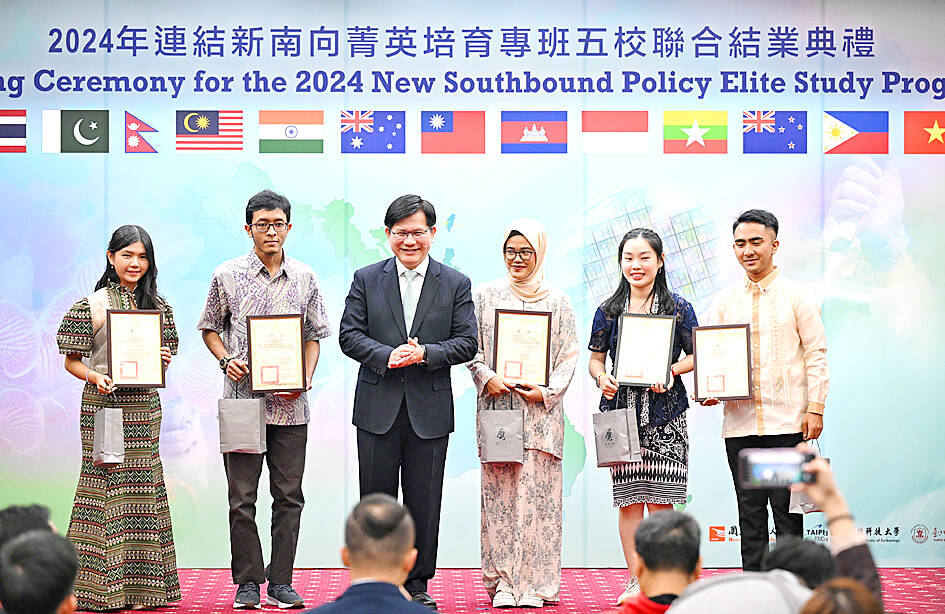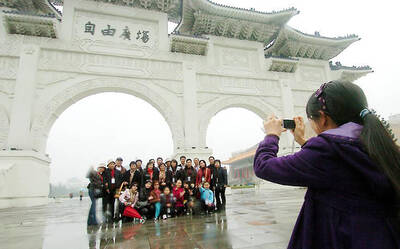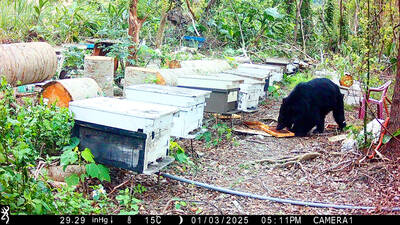Minister of Foreign Affairs Lin Chia-lung (林佳龍) yesterday praised the 104 university students who recently concluded a five-month study program offered as part of the government’s New Southbound Policy, adding that they would bolster people-to-people exchanges with Taiwan.
The graduates of the New Southbound Policy Elite Study Program came from 12 partner countries from among the 18 covered under the policy, which includes ASEAN members, South Asian countries, Australia and New Zealand.
They underwent a five-month immersive program introducing them to Taiwan’s society and democracy, and teaching them Mandarin, Lin said in his address at a ceremony marking the program’s conclusion at the Ministry of Foreign Affairs in Taipei.

Photo: Chang Chia-ming, Taipei Times
The program also included a series of cultural activities and tours of local businesses, focused particularly on some of Taiwan’s more advanced medical, semiconductor and smart agriculture sectors, Lin said.
“Through the friendships that you have made here, relations between Taiwan and the nations you represent will deepen,” he said.
He urged the graduates from Australia, Cambodia, India, Indonesia, Malaysia, Myanmar, Nepal, New Zealand, Pakistan, the Philippines, Thailand and Vietnam to share their experience in Taiwan with their friends and families in their home countries.
“In the coming years, I hope to welcome even more participants from partner countries to this program so that our nations can grow and prosper together,” he added.
The New Southbound Policy Elite Study Program, launched in 2022, seeks to train talented individuals from New Southbound Policy nations.
In its third year, the program has hosted 221 students.
The program covers each student’s tuition and round-trip airfare, as well as accommodation and a monthly stipend of NT$8,000.
This year’s program partnered with five Taiwanese universities — Taipei Medical University, National Taipei University of Technology, National Pingtung University of Science and Technology, National Chung Hsing University in Taichung and National Quemoy University in Kinmen County.
The program is among the initiatives of the New Southbound Policy, which was launched in 2016 under then-president Tsai Ing-wen (蔡英文) to expand the country’s economic, educational and cultural links with Southeast Asian and Asia-Pacific nations.

SHIPS, TRAINS AND AUTOMOBILES: The ministry has announced changes to varied transportation industries taking effect soon, with a number of effects for passengers Beginning next month, the post office is canceling signature upon delivery and written inquiry services for international registered small packets in accordance with the new policy of the Universal Postal Union, the Ministry of Transportation and Communications said yesterday. The new policy does not apply to packets that are to be delivered to China, the ministry said. Senders of international registered small packets would receive a NT$10 rebate on postage if the packets are sent from Jan. 1 to March 31, it added. The ministry said that three other policies are also scheduled to take effect next month. International cruise ship operators

NUMBERS IMBALANCE: More than 4 million Taiwanese have visited China this year, while only about half a million Chinese have visited here Beijing has yet to respond to Taiwan’s requests for negotiation over matters related to the recovery of cross-strait tourism, the Tourism Administration said yesterday. Taiwan’s tourism authority issued the statement after Chinese-language daily the China Times reported yesterday that the government’s policy of banning group tours to China does not stop Taiwanese from visiting the country. As of October, more than 4.2 million had traveled to China this year, exceeding last year. Beijing estimated the number of Taiwanese tourists in China could reach 4.5 million this year. By contrast, only 500,000 Chinese tourists are expected in Taiwan, the report said. The report

The Forestry and Nature Conservation Agency yesterday launched a gift box to market honey “certified by a Formosan black bear” in appreciation of a beekeeper’s amicable interaction with a honey-thieving bear. Beekeeper Chih Ming-chen (池明鎮) in January inspected his bee farm in Hualien County’s Jhuosi Township (卓溪) and found that more than 20 beehives had been destroyed and many hives were eaten, with bear droppings and paw prints near the destroyed hives, the agency said. Chih returned to the farm to move the remaining beehives away that evening when he encountered a Formosan black bear only 20m away, the agency said. The bear

HORROR STORIES: One victim recounted not realizing they had been stabbed and seeing people bleeding, while another recalled breaking down in tears after fleeing A man on Friday died after he tried to fight the knife-wielding suspect who went on a stabbing spree near two of Taipei’s busiest metro stations, Taipei Mayor Chiang Wan-an (蔣萬安) said. The 57-year-old man, identified by his family name, Yu (余), encountered the suspect at Exit M7 of Taipei Main Station and immediately tried to stop him, but was fatally wounded and later died, Chiang said, calling the incident “heartbreaking.” Yu’s family would receive at least NT$5 million (US$158,584) in compensation through the Taipei Rapid Transit Corp’s (TRTC) insurance coverage, he said after convening an emergency security response meeting yesterday morning. National